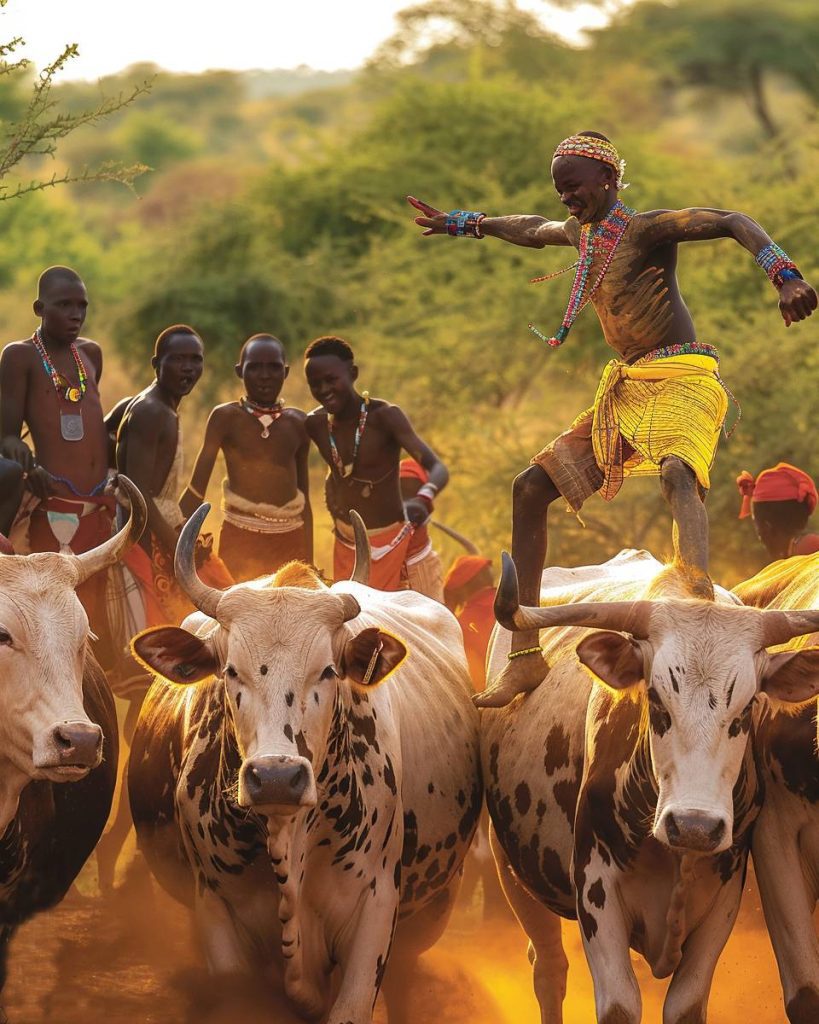In the remote corners of Ethiopia’s Omo Valley, a centuries-old tradition unfolds that challenges our understanding of coming-of-age rituals.
Picture a young man, his body painted and adorned with beads, standing before a line of cattle. The air is thick with anticipation as he prepares to make a leap that will forever change his life.
This is the Hamar bull jumping ceremony, a rite of passage that transforms boys into men.
The initiate must run across the backs of several bulls lined up side by side, not once but four times, without falling to prove his worthiness for marriage and manhood in Hamar society.
It’s a test of courage, agility, and determination that has captivated anthropologists and travelers alike.
The bull jumping ceremony is more than just a physical feat; it’s a complex tapestry of cultural significance.
As the young man prepares for his momentous leap, the community gathers in a spectacle of song, dance, and rituals that highlight the interconnectedness of the Hamar people.
This event offers a rare glimpse into a world where tradition and modernity collide, challenging our notions of what it means to become an adult in today’s rapidly changing global landscape.
The Cultural Tapestry of the Hamar Tribe
The Hamar tribe’s rich cultural traditions reflect a complex tapestry of beliefs, rituals, and social structures.
Their customs, particularly the renowned bull jumping ceremony, offer profound insights into their way of life and values.
Origins and Significance
The Hamar people, residing in Ethiopia’s Omo Valley, have cultivated a unique cultural identity over centuries.
Their bull jumping ceremony stands as a cornerstone of their heritage, embodying the tribe’s reverence for cattle and the transition to manhood.
This rite of passage, known as “ukuli,” serves multiple purposes within Hamar society. It not only tests a young man’s physical prowess but also solidifies his place in the community’s social fabric.
Interestingly, the ceremony’s origins remain shrouded in mystery. Some anthropologists speculate it evolved from ancient hunting rituals, while others suggest it symbolizes the tribe’s historical relationship with their livestock.
Rites of Passage
The bull jumping ceremony unfolds over three days, each phase steeped in symbolism.
The initiate, called an “ukuli,” must leap naked over a line of cattle, demonstrating his readiness for adult responsibilities.
This feat requires not just physical strength but mental fortitude. A successful jump grants the young man the right to marry and own cattle, pivotal markers of status in Hamar society.
Curiously, the ceremony involves more than just the jumper. Female relatives endure ritualistic whipping, a practice believed to create a lifelong bond between the women and the newly initiated man.
The event culminates in communal celebration, reinforcing social ties and cultural continuity. Through this intricate ritual, the Hamar people preserve their unique identity in a rapidly changing world.
Ceremony in Detail
The Hamar bull jumping ceremony is a complex ritual filled with symbolism and cultural significance. It marks a pivotal moment in a young man’s life, testing his courage and marking his transition into adulthood.
Preparation and Anticipation
The ceremony begins long before the actual jump. Young men, known as Ukuli, spend months preparing physically and mentally for this momentous occasion.
They undergo rigorous training, honing their agility and strength.
Elders select a date based on astrological signs and community readiness. As the day approaches, excitement builds in the village. Families gather supplies for the feast that will follow the successful jump.
The Ukuli fasts and meditates, focusing his mind on the task ahead. He receives blessings from elders and undergoes purification rituals to ensure divine favor.
The Leap of Faith
The heart of the ceremony lies in the daring leap over a line of cattle.
Ten to thirty bulls are lined up, their backs smeared with dung to make them slippery.
The Ukuli must run across the backs of the bulls four times without falling. Each successful crossing represents a season of the year. A single misstep could result in injury or even death.
As he jumps, the crowd cheers, offering encouragement and praise. The atmosphere is electric, filled with tension and excitement. Drums beat rhythmically, adding to the intensity of the moment.
Roles and Participation
The ceremony involves the entire community, with each member playing a specific role:
- Ukuli: The initiate performing the jump
- Maza: Former jumpers who assist and protect the Ukuli
- Women: Sing, dance, and undergo a whipping ritual to show support
- Elders: Oversee the ceremony and give blessings
- Bulls: Carefully selected and prepared for the jump
The Maza plays a crucial role, catching the Ukuli if he falls and ensuring the bulls remain in line. Their experience and guidance are invaluable to the jump’s success.
Adornment and Symbolism
The visual elements of the ceremony are rich with meaning. The Ukuli is adorned with special attire:
- Beaded necklaces represent his unmarried status
- A leather cape symbolizing his boyhood
- Bells tied to his ankles to announce his presence
After the successful jump, the Ukuli receives new adornments, signifying his new status as a man. These may include:
- A feathered headdress
- A special staff or walking stick
- Body paint in intricate patterns
Each element carries deep cultural significance, telling the story of the Ukuli’s journey from boy to man. The community recognizes these symbols, instantly understanding the wearer’s status and accomplishments.

